The Bernese Oberland, this is where mighty, snow-capped mountains tumble down into lush, green valleys. Waterfalls spill over the cliffs, cows and their musical bells wander the fields, charming villages dot the hillsides, and hiking trails connect small hamlets and towns.
Located in central Switzerland, the Bernese Oberland is home to some of the most dramatic mountain scenery in all of Europe. For many visitors (ourselves included), this region is the highlight of a trip to Switzerland. The alpine views, the cozy, charming villages, and the soaring cable cars create a magical destination.
On a map, the Bernese Oberland can look confusing to a first-time visitor. With its geography, complex public transportation network, long list of things to do, and multiple options on where to stay, it can feel like a daunting task to plan a trip here. We felt the same way.
In this Bernese Oberland guide, I hope to clear up this confusion and hopefully answer some questions that you didn’t even know you had. And of course, if we missed something, feel free to ask us in the comment section at the end of this article.
Overview of the Bernese Oberland
The Bernese Oberland, also called the Bernese Highlands or the Bernese Alps, is a region in central Switzerland. It is part of the canton of Bern and it encompasses a portion of the Swiss Alps, including the Jungfrau massif, Lauterbrunnen Valley, Interlaken, Lake Brienz and Lake Thun, and extends west to Adelboden and Gstaad.
The Jungfrau region is a smaller portion of the Bernese Oberland. This region includes the Jungfrau massif, the Lauterbrunnen Valley, Schilthorn, Mürren, Gimmelwald, Grindelwald, and Interlaken. The Jungfrau region is the touristy heart of the Bernese Oberland and this is where most visitors spend their time.
This article focuses on the Jungfrau region of the Bernese Oberland.
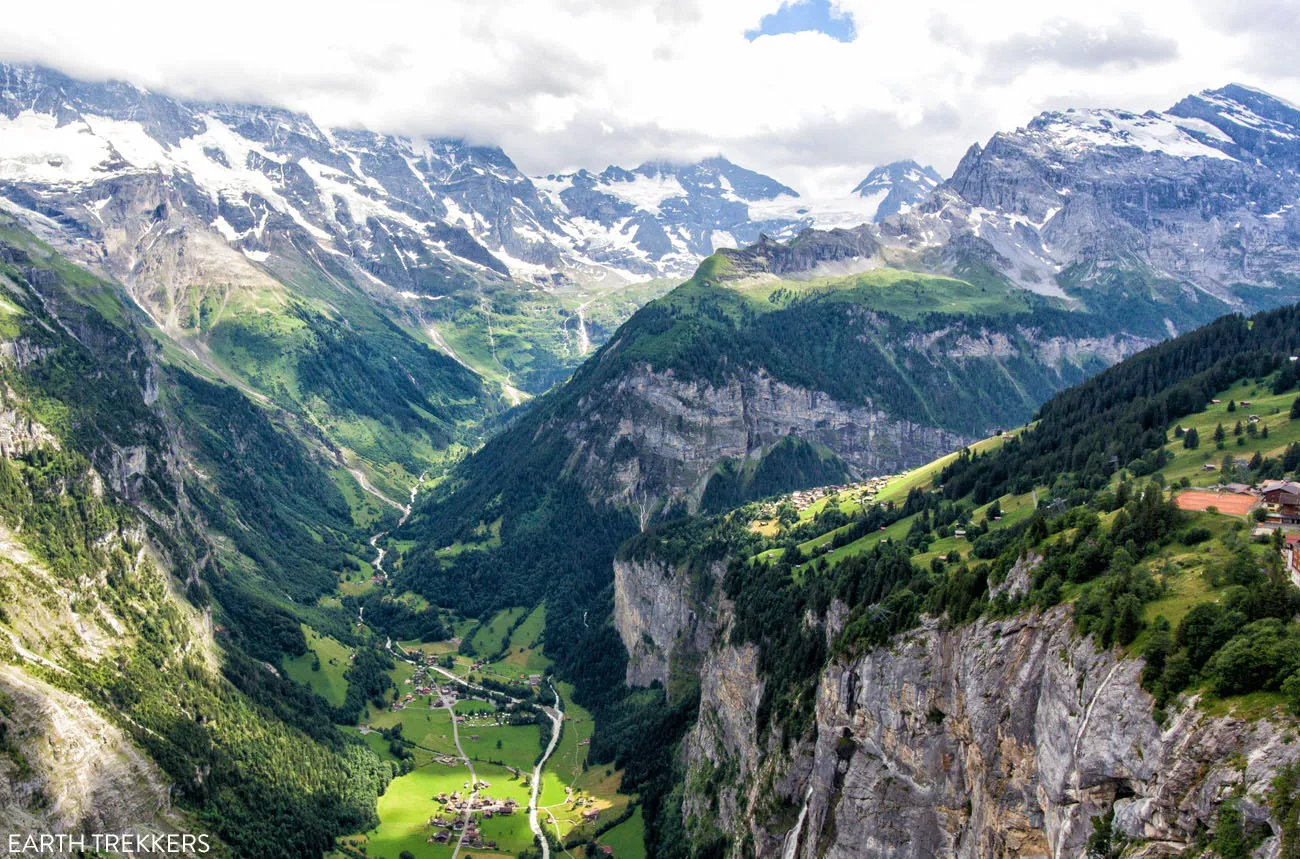
Drone photo of the Lauterbrunnen Valley
Bernese Oberland Geography Lesson
The Bernese Alps is where you will find some of the most iconic mountains in the Alps. The mighty Jungfrau massif, made up of Eiger, Mönch, and Jungfrau, dominates the region.
Within the Jungfrau region sits two valleys, the Lauterbrunnen valley and Lütschental valley. The mountains of the Swiss Alps tower over these valleys. Small towns cling to the cliffs and are tucked away in these valleys.
It’s a lot easier to understand the geography of the Jungfrau region if you look at a map.
Below is a map of the Jungfrau region. Interlaken is at the bottom of the map and Lauterbrunnen Valley and Lütschental Valley run through the heart of the region. On this map I highlighted the main towns.
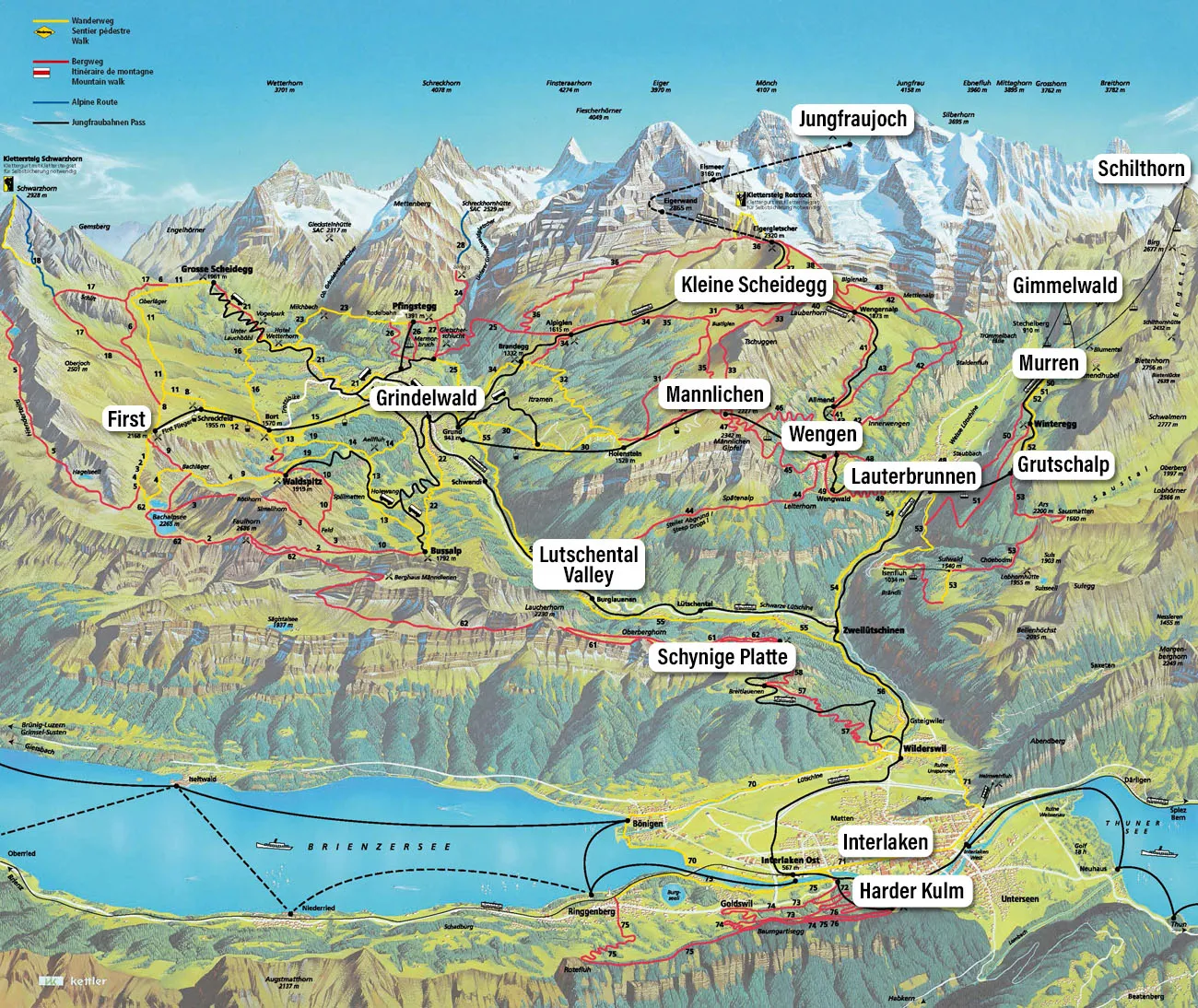
The Lauterbrunnen Valley splits the Jungfrau regions into two parts. In the east is the Jungfrau Massif: Mönch, Eiger, and Jungfrau. This is where you will find:
- Jungfraujoch
- Kleine Scheidegg
- Wengen
- The Eiger Trail
- The Männlichen to Kleine Scheidegg hike
In the west is another mountain range. This is where you will find:
- Schilthorn and Birg
- Mürren
- Gimmelwald
- Grütschalp
In the Lauterbrunnen Valley, you will see:
- Lauterbrunnen
- Stechelberg
- Trummelbach Falls
- Staubbach Falls
A second valley runs through the region. Called the Lütschental Valley, it starts near Lauterbrunnen and ends at Grindelwald. To the south of this valley is the Jungfrau massif. To the north is another mountain range. This is where you will find:
- First
- First Cliff Walk
- Bachalpsee
- Schynige Platte
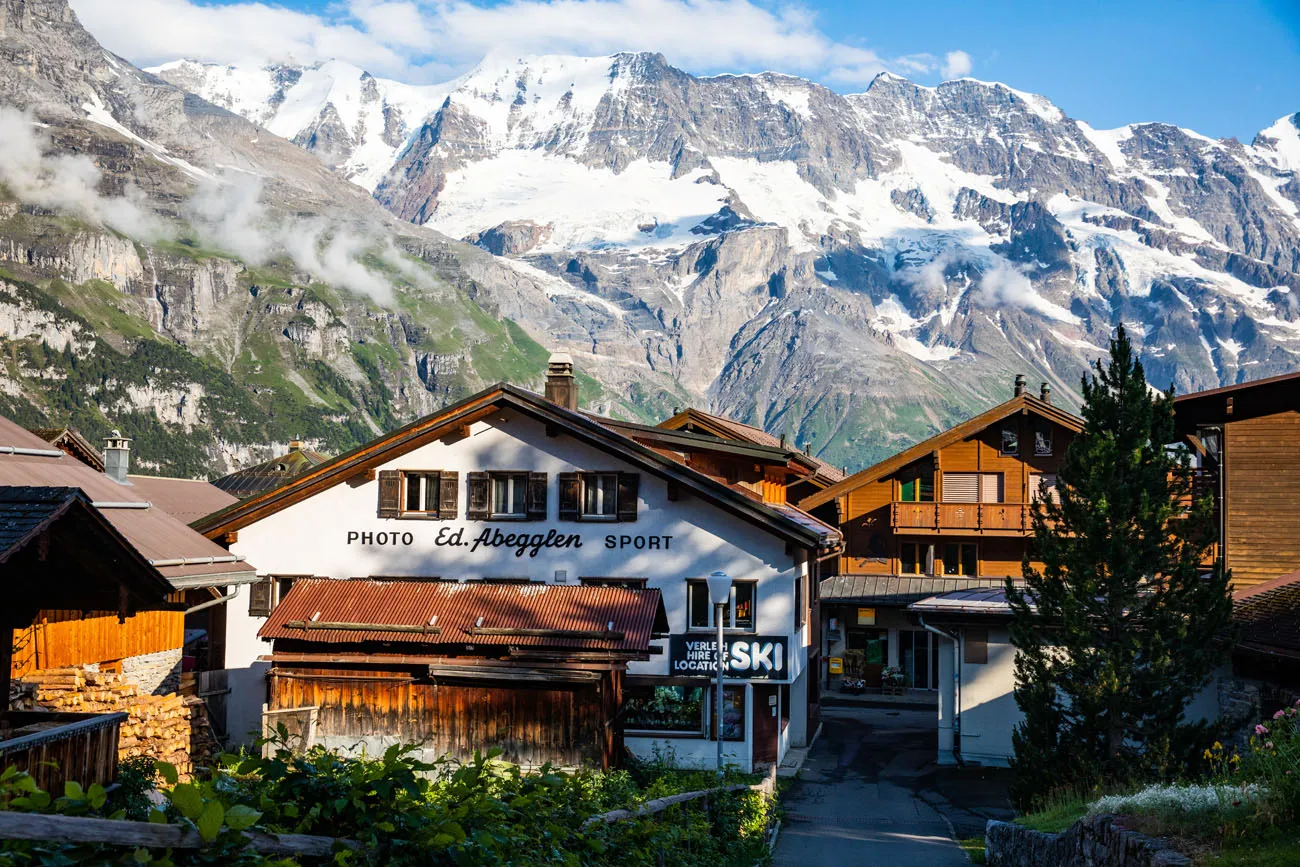
Mürren
Main Towns in the Jungfrau Region
Interlaken
Interlaken is a large town that is sandwiched between Lake Brienz and Lake Thun. It is located just outside of Lauterbrunnen Valley. This is the main transportation hub for the area.
To get the Jungfrau region, you will first travel to Interlaken, either by car or by train. From Interlaken, you will take the train to Lauterbrunnen or Grindelwald, and continue into the mountains from there.
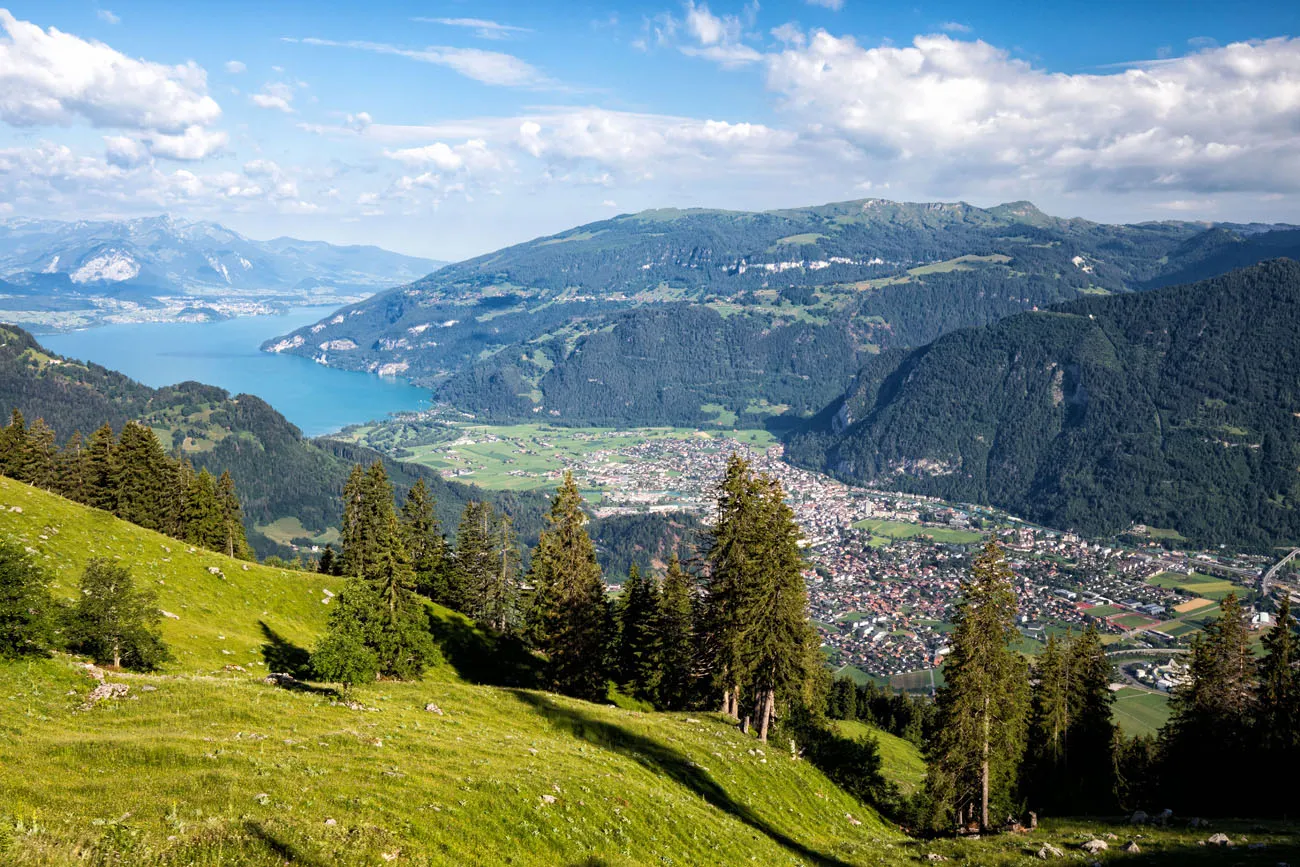
A view of Interlaken from Schynige Platte
Lauterbrunnen
This is one of the most famous and the most picturesque towns in the Jungfrau region. Rustic houses, Swiss chalets, hotels, and restaurants are all clustered together, while Staubbach Falls cascades down the sheer cliff next to the town.
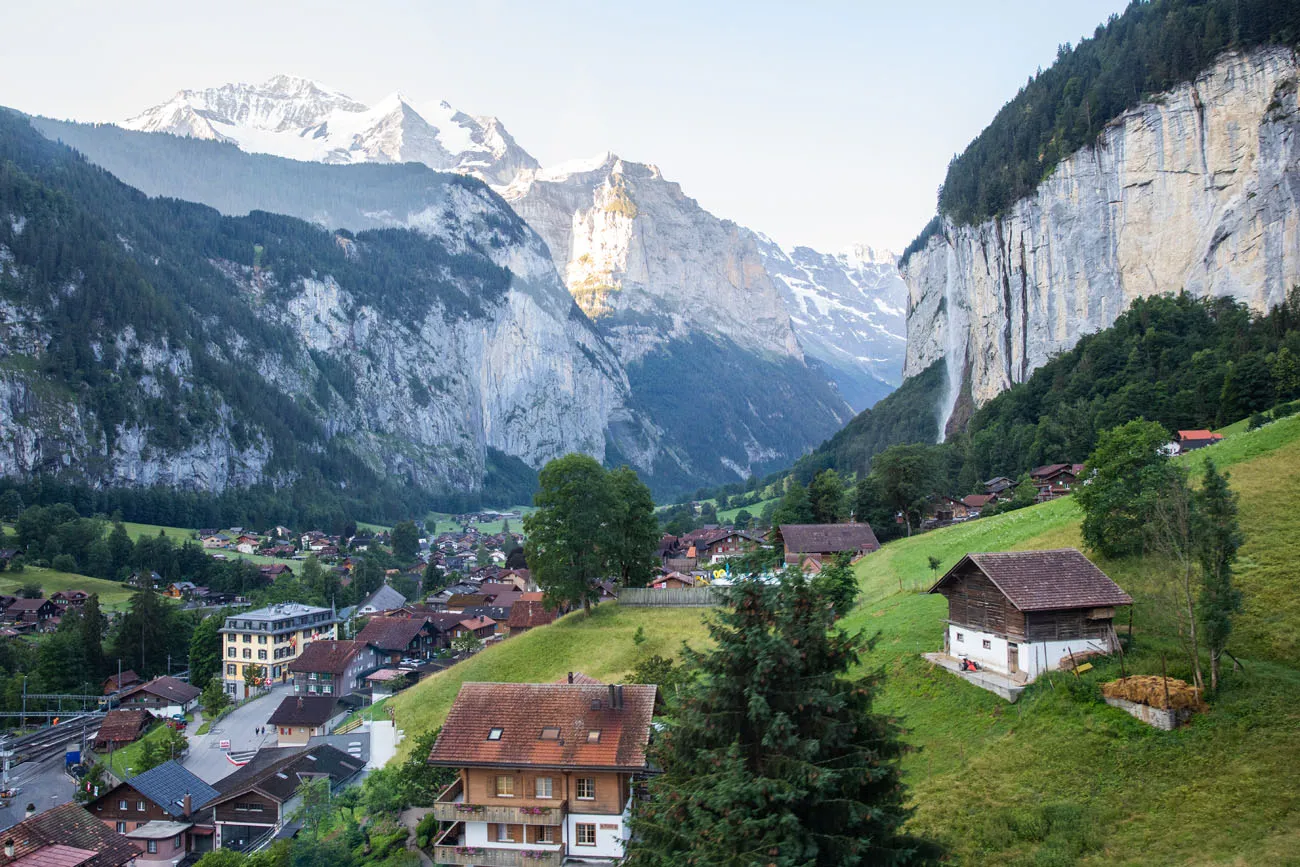
Lauterbrunnen sits in the Lauterbrunnen Valley. With a train station and a cable car station, it is relatively easy to get around the Jungfrau region from here, so this is one of the best towns to stay in if you are looking for convenience. However, since you are in the valley, don’t expect to get alpine views from your hotel room.
Grindelwald
Grindelwald is a large town that sits in the Lütschental Valley. This also makes a handy place to stay for visitors, with its train station, cable cars, and convenient location near First. However, it lacks the charm that you find in the other towns on this list.
Wengen
Wengen sits on the cliffs overlooking the Lauterbrunnen Valley. It sits at the base of Männlichen and because of its location, it’s easy to get to Kleine Scheidegg from here. Within this large town are numerous hotels and restaurants, so this is a popular place to stay.
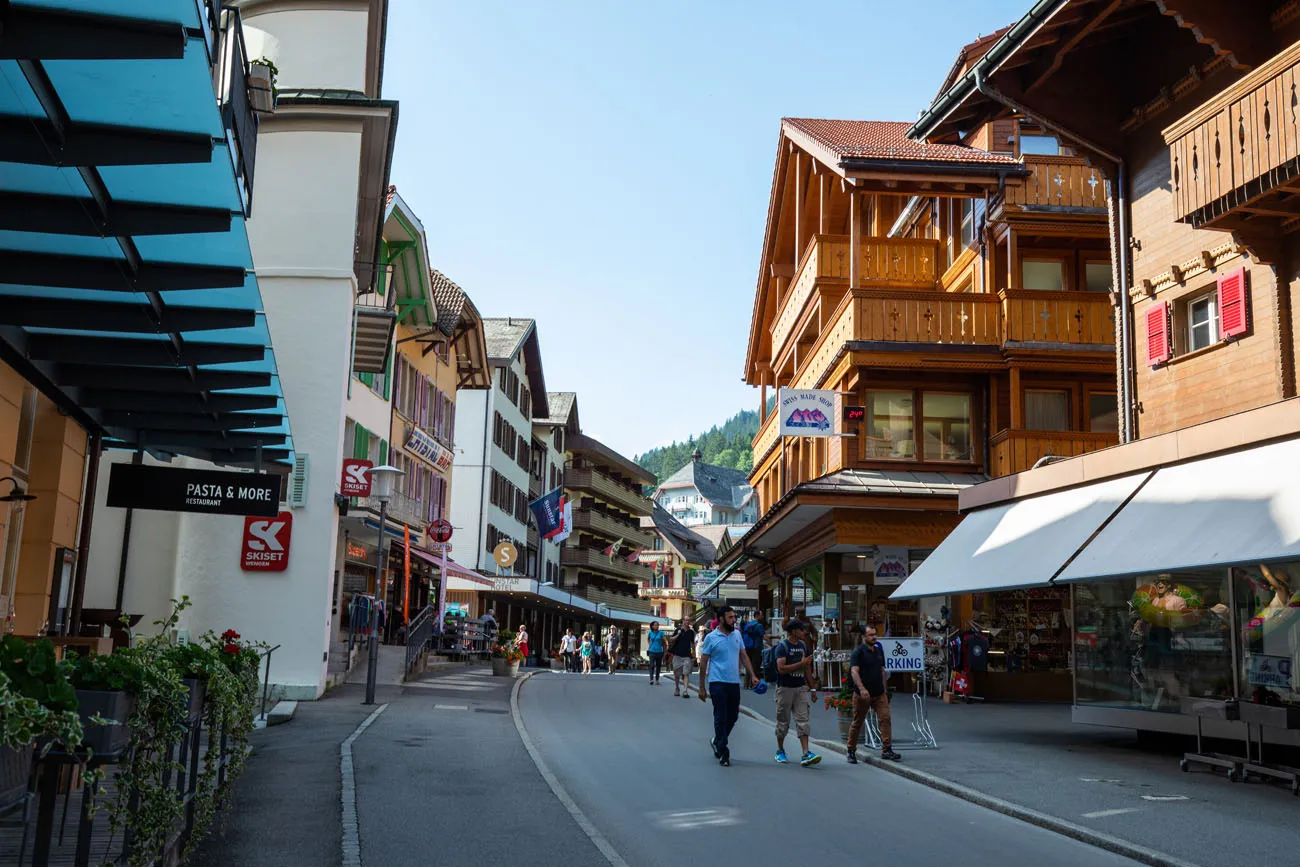
Wengen
Kleine Scheidegg
The main reason to visit Kleine Scheidegg is to take the train to Jungfraujoch. However, there are several great hiking trails that start and end at this high-alpine town, such as the Panorama Trail from Männlichen to Kleine Scheidegg.
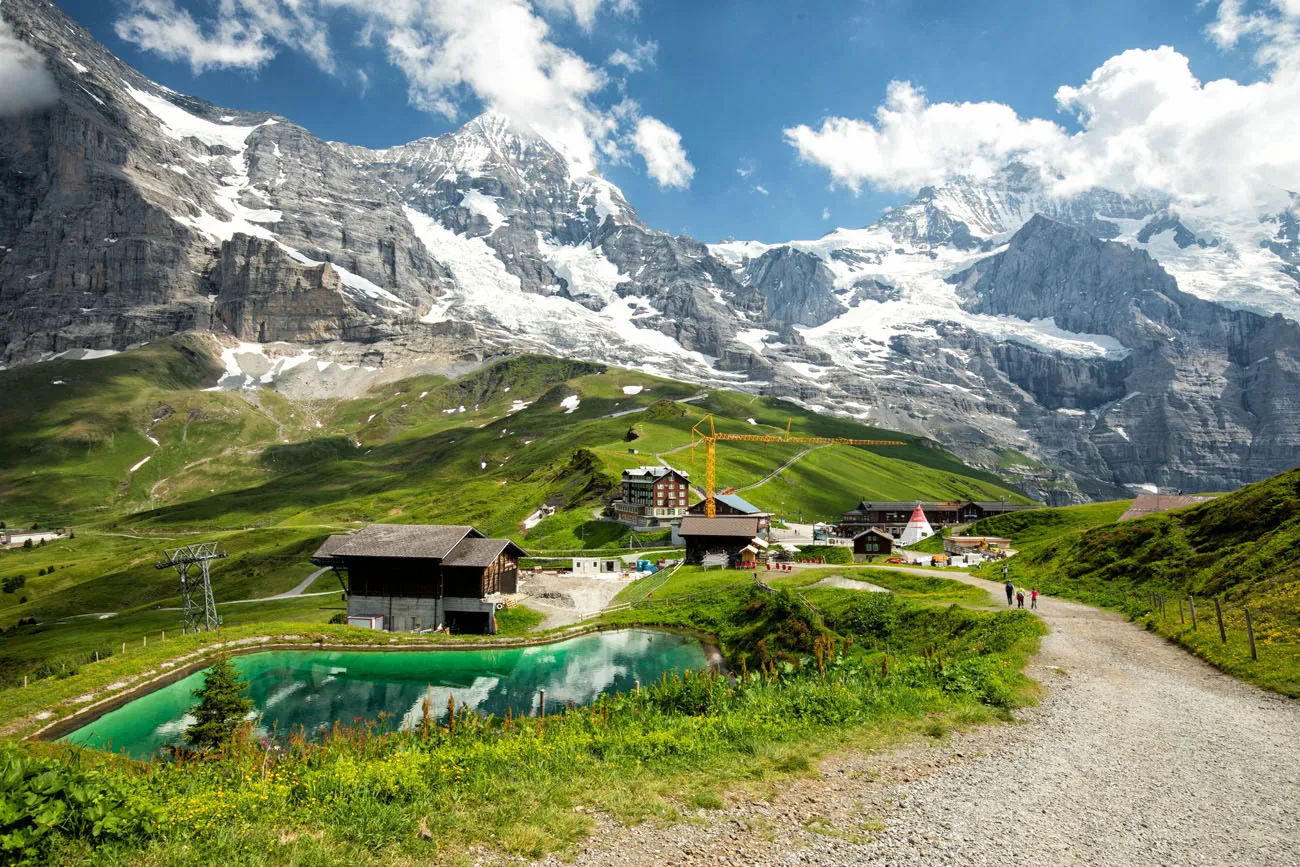
Kleine Scheidegg
Mürren
Mürren is a very charming town that clings to the cliff high above the Lauterbrunnen Valley. From Mürren, you get jaw-dropping views of Eiger, Mönch, and Jungfrau, so if you want to book a hotel room in the Jungfrau with an unforgettable view, this is the place to do it.
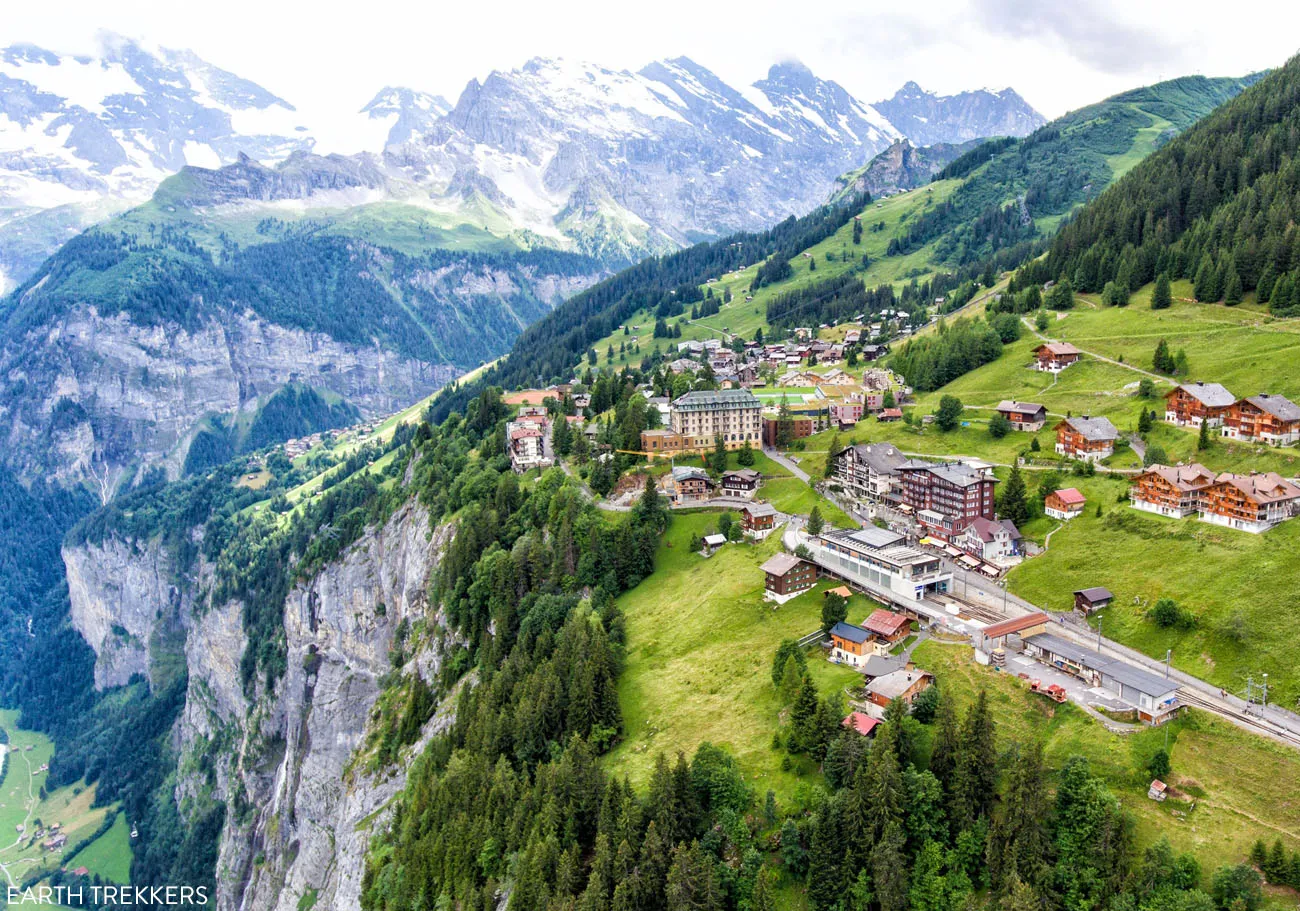
Drone photo of Mürren
This is where we stayed and we highly recommend it. From our room at the Alpenblick Hotel, we had a spectacular view of the Swiss Alps, and it was a wonderful way to start and end our days here.
Since Mürren is located up in the mountains, it does take longer to get around. You are conveniently close to Schilthorn and Birg, but when you want to visit Jungfraujoch, First, or Schynige Platte, you will have a longer journey than if you stayed in Lauterbrunnen.
Gimmelwald
Gimmelwald is a tiny, postcard perfect town located on the cliffs that tower over the Lauterbrunnen Valley. This town is smaller, less touristy version of Mürren.
It also takes longer to get to, which for some, is why it is so charming. If you want to stay in a quieter, less touristy town, Gimmelwald is our top pick.
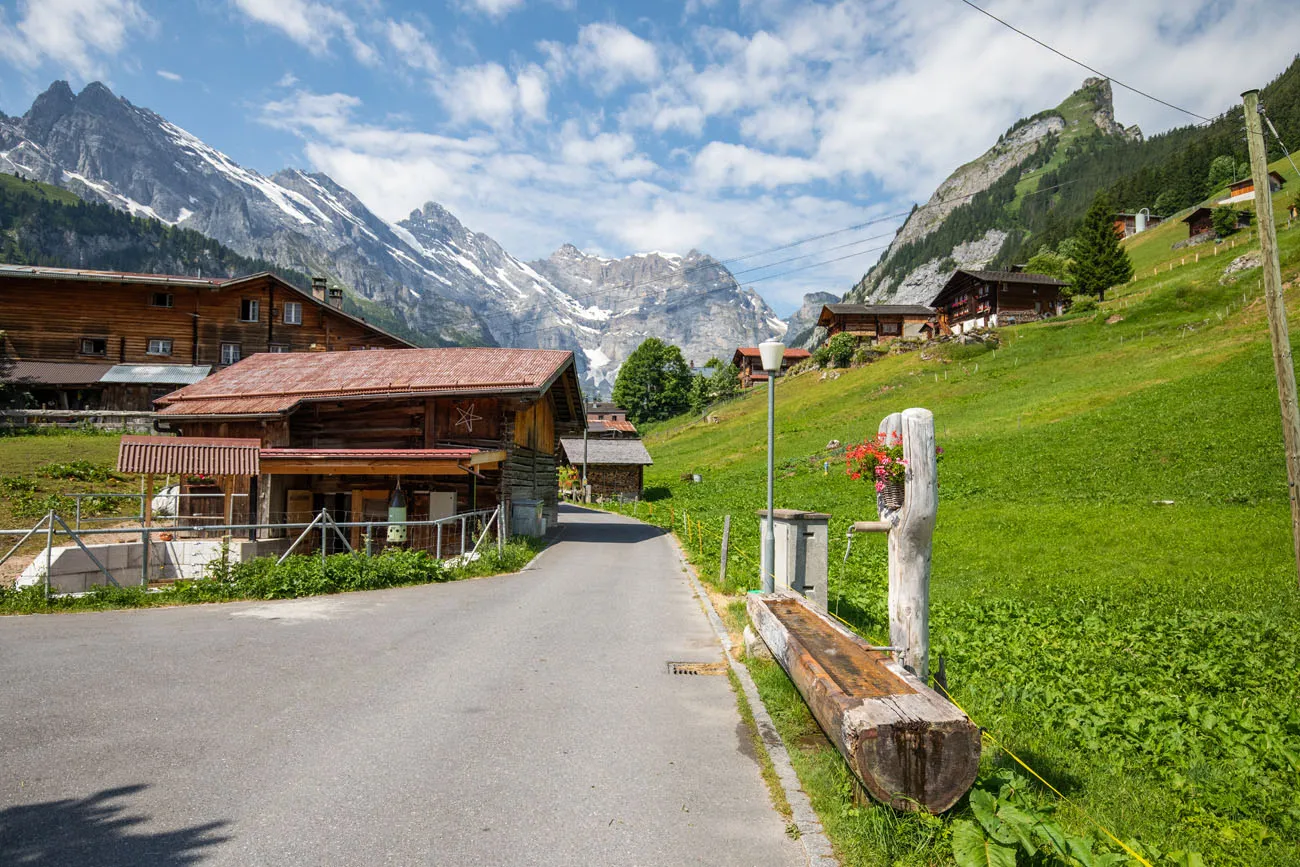
Gimmelwald
Stechelberg
Stechelberg is located at the far end of Lauterbrunnen Valley. It’s main claim to fame is the enormous public parking lot (if you arrive to the Jungfrau region by car, most likely this is where you will park) and the cable car that runs to Gimmelwald and Mürren.
Wilderswil
Wilderswil is a small town that is located between Interlaken and Lauterbrunnen. There are several accommodation options here, but the real reason for visiting Wilderswil is to catch the train to Schynige Platte.
How to Get to the Bernese Oberland
Interlaken is the gateway into the Jungfrau region. All roads and trains travel through Interlaken before heading up the Lauterbrunnen Valley into the Jungfrau region.
By Train
If you are traveling through Switzerland by train, you will first go to Interlaken and then transfer to a train to Lauterbrunnen or Grindelwald, depending on where you are staying.
Travel Times to Interlaken by Train:
- Zürich: 2.5 hours
- Lucerne: 1.75 hours
- Bern: 45 minutes
- Geneva: 2.75 hours
- Lausanne: 2.5 hours
- Zermatt: 2.5 hours
By Airplane
The closest airport is in Bern but there are also airports in Geneva and Zürich. From the airport, you can take the train to Interlaken.
By Car
There is no real need for a car when visiting the Jungfrau area of the Bernese Oberland. Mürren, Gimmelwald, and Wengen are car-free towns. You can get to Lauterbrunnen and Grindelwald by car but once here, you will be using the trains and cable cars to get around.
For the duration of your stay in the Bernese Oberland, your car will sit in the parking lot. There is a daily fee for parking, plus what you are paying in rental fees. So, if you are planning a visit of several days or longer, it is best to return your rental car before this part of your trip.
Parking in Lauterbrunnen
There is a parking garage in Lauterbrunnen. You can reserve your parking space in advance (highly recommended!). For parking rates and to make your reservation click here.
Parking in Grindelwald
There is a public parking area at the Grindelwald Grund train station that has 300 spaces. At Parkhouse Eiger there are 252 spaces and at Parkhaus Sportzentrum there are 160 spaces.
Parking in Stechelberg
At the Schilthornbahn in Stechelberg, there are 1500 spaces. For the price list, click here.
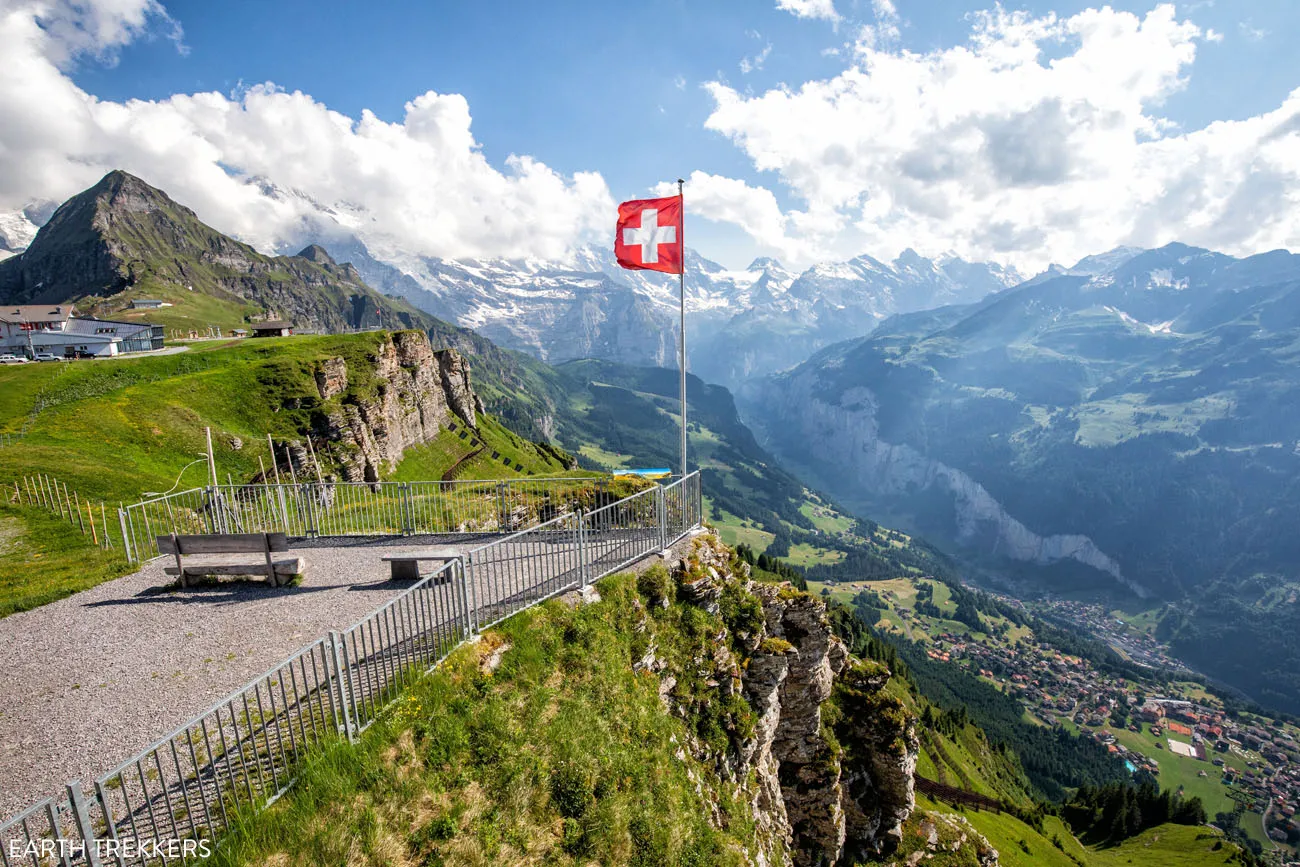
View from Männlichen
Getting Around the Bernese Oberland
This is one of the most confusing aspects of planning a visit to the Bernese Oberland.
Trains, cable cars, and buses connect all of the towns and the main attractions of the Jungfrau region. Depending on where you are staying and where you are going, there is a very good chance that you will use a combination of these transportation modes to get around.
Below we list the trains and cable cars in the region. You can see the timetables for these on the Jungfrau website. And here is the link for the price list.
Train from Interlaken to the Jungfrau Region
From Interlaken, you will take the train to Lauterbrunnen or Grindelwald. From Lauterbrunnen and Grindelwald, continue your journey into the mountains by cable car or a different train.
Grütschalp Cable Car
This cable car links Lauterbrunnen with Grütschalp. The cable runs every 30 minutes and the travel time is 4 minutes.
Train Grutschalp to Mürren
The train connects Mürren to Winteregg and Grütschalp. The train leaves every 30 minutes and travel time is 13 minutes.
NOTE: The timetable is planned so you do not have to wait for the next train or cable car. For example, if you ride the cable car from Lauterbrunnen to Grütschalp, you will immediately board the train to Mürren and it will depart within just a few minutes. And if you ride the train from Mürren to Grütschalp, you will immediately board the cable car and depart for Lauterbrunnen.
Schilthornbahn
The Schilthornbahn is a series of cable cars that start in Stechelberg and continues to Gimmelwald, Mürren, Birg, and Schilthorn. You can get on and off the cable car at any of these stations. The Schilthornbahn has a separate timetable than the other trains and cable cars on this list, which you can see here.
IMPORTANT: A new cable car system is currently being constructed from Stechelberg to Mürren to Schilthorn. It will be replacing the original cable car route. The original cable cars are still in operation, so you can still visit Schilthorn, but readers are reporting that the Birg Thrill Walk is closed and that the construction materials are taking away from the view at Schilthorn. This construction project is planned through 2026. Learn more here.
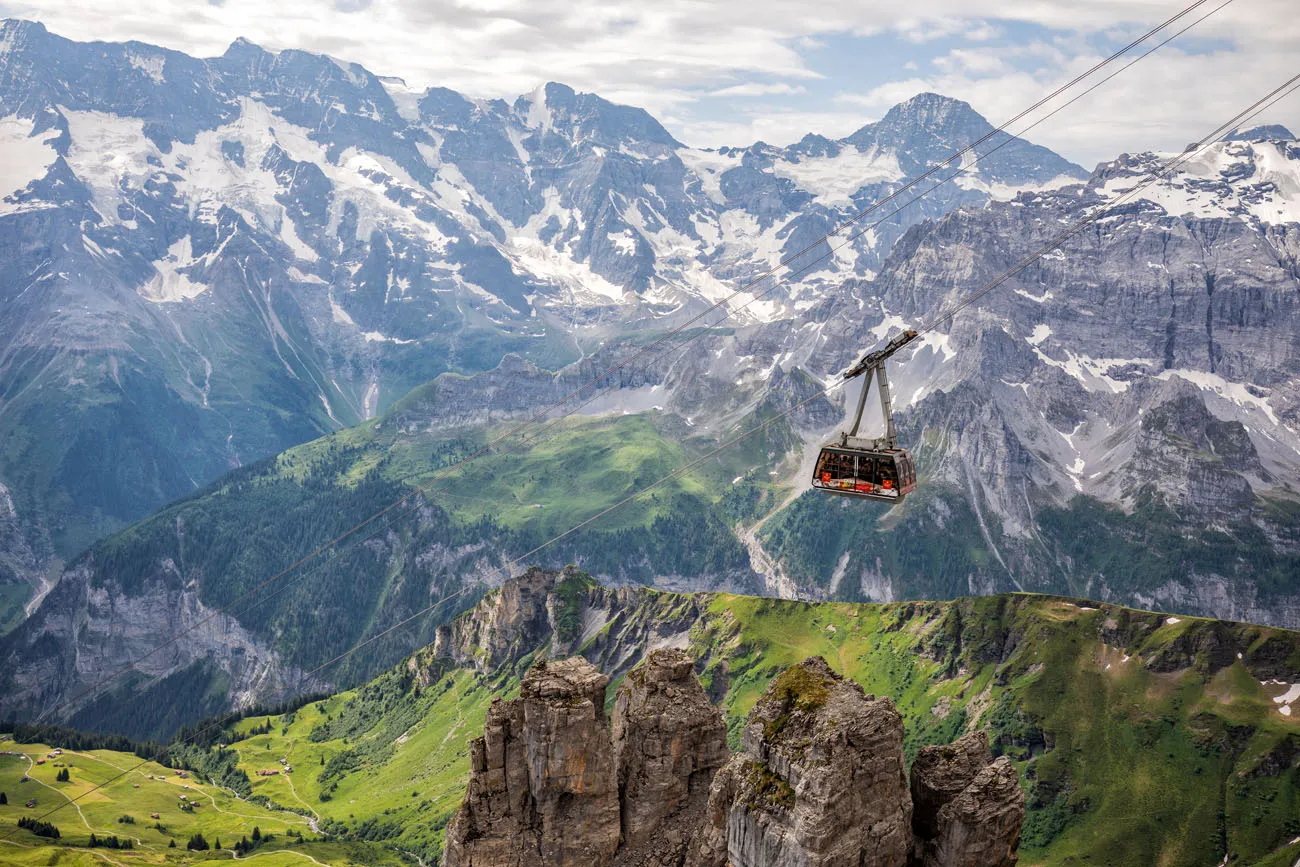
Schilthornbahn
Wengernalpbahn: Lauterbrunnen to Wengen to Kleine Scheidegg
This train starts in Lauterbrunnen and travels through Wengen and several smaller villages before arriving at Kleine Scheidegg. If you are traveling to Jungfraujoch from Lauterbrunnen, Mürren, or Gimmelwald, this is the train you will take.
PRO TRAVEL TIP: Sit on the right side of the train for the best views of the Lauterbrunnen Valley.
Jungfraubahn (Kleine Scheidegg to Jungfraujoch)
The Jungfraubahn is the final leg of the journey to Jungfraujoch. Most of this ride is in a dark tunnel, so it is not the most scenic train ride. It takes 35 minutes to travel from Kleine Scheidegg to Jungfraujoch.
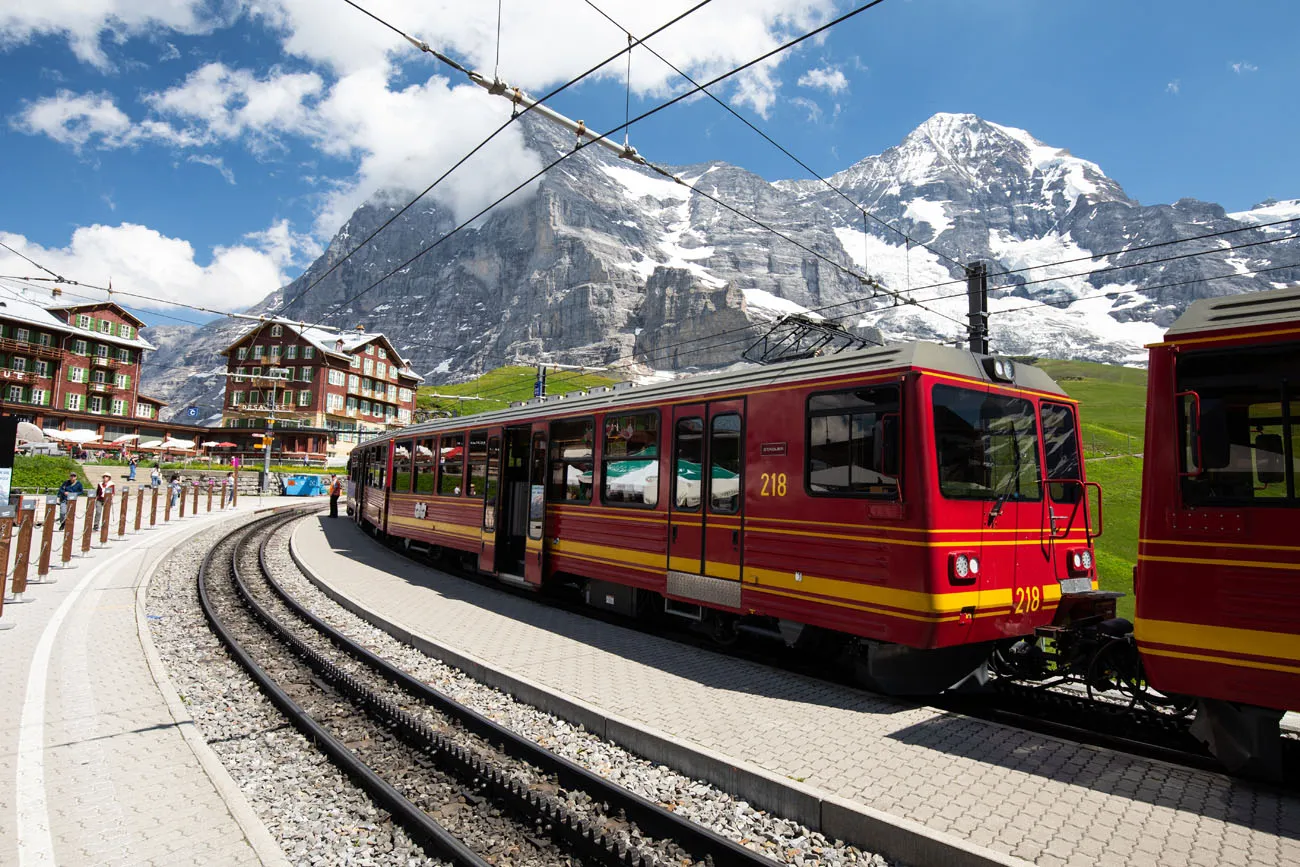
Jungfraubahn
Train Grindelwald to Kleine Scheidegg
You can also get to Kleine Scheidegg by taking the train from Grindelwald Grund. The train passes through the small town of Alpiglen.
Wengen-Männlichen Aerial Cableway
This cable car connects the town of Wengen with Männlichen.
The Eiger Express
This is a gondola cableway links Grindelwald to Männlichen and the Eigergletscher railway station and opened in December 2020.
Grindelwald Cable Car
From Grindelwald, ride the series of cable cars to First.
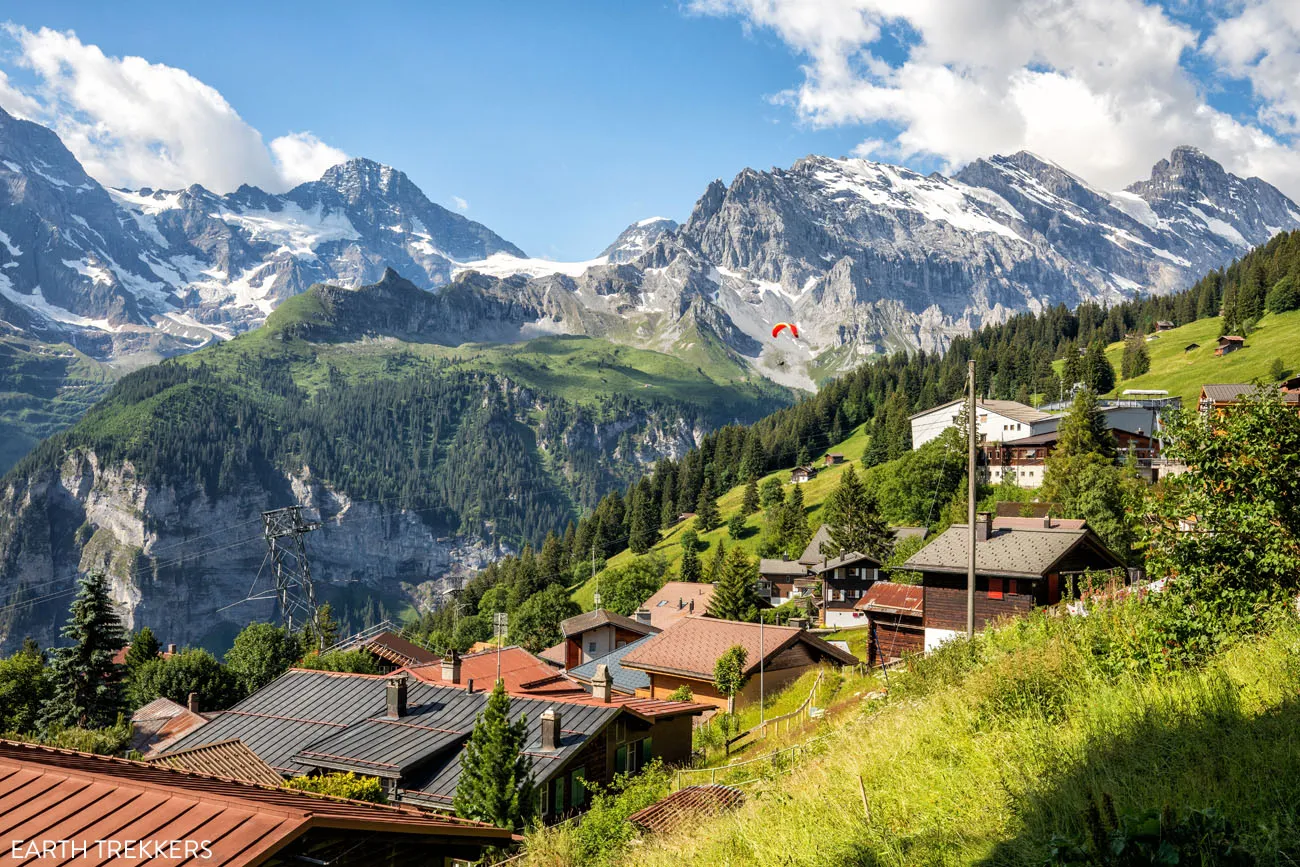
Mürren
Putting This All Together
I know that is an overwhelming list of trains and cable cars for such a small geographical area. Here are some of the most popular routes in the Jungfrau region:
Interlaken to Lauterbrunnen: The train runs every 30 minutes and the travel time is 30 minutes.
Interlaken to Grindelwald: The train runs every 30 minutes and the travel time is 42 minutes.
Interlaken to Mürren: Option #1: train to Lauterbrunnen, cable car to Grütschalp, train to Mürren. Option #2: train to Lauterbrunnen, bus to Stechelberg, cable car to Mürren.
Interlaken to Gimmelwald: Train to Lauterbrunnen, bus to Stechelberg, cable car to Gimmelwald
Interlaken to Wengen: Train to Lauterbrunnen, Wengernalpbahn to Wengen.
Interlaken to Jungfraujoch: Train to Grindelwald, Eiger Express to Eigergletscher, Jungfraubahn to Jungfraujoch
Grindelwald to Jungfraujoch: Eiger Express to Eigergletscher, Jungfraubahn to Jungfraujoch
Mürren to Jungfraujoch: Train to Grütschalp, cable car to Lauterbrunnen, Wengernalpbahn to Kleine Scheidegg, Jungfraubahn to Jungfraujoch.
Gimmelwald to Jungfraujoch: Cable car to Stechelberg, bus to Lauterbrunnen, Wengernalpbahn to Kleine Scheidegg, Jungfraubahn to Jungfraujoch
Lauterbrunnen to First: Train to Grindelwald, cable car to First.
Grindelwald to Mürren: Train to Lauterbrunnen, cable car to Grütschalp, train to Mürren
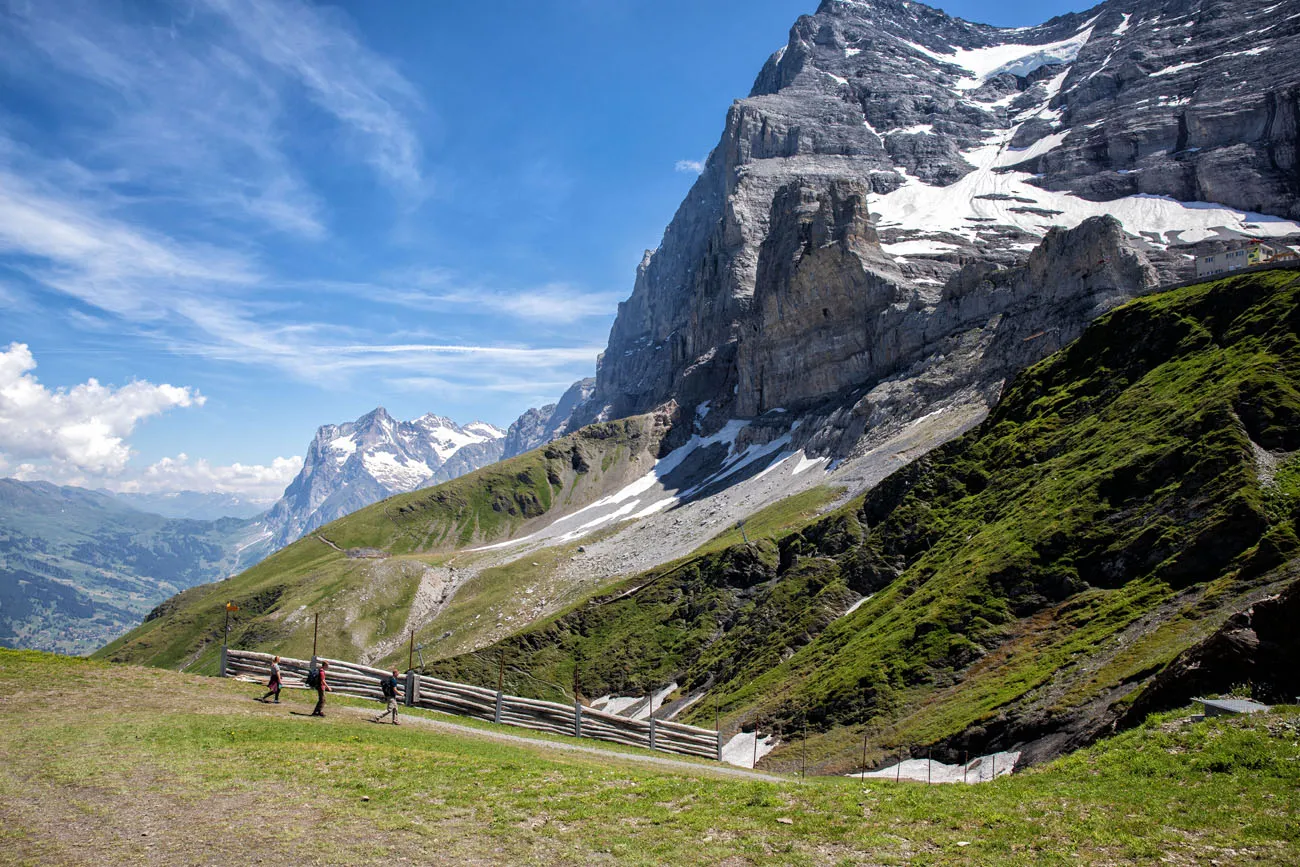
Eiger Trail
Travel Passes for the Jungfrau Region
If you thought figuring out how to get around was complicated, just wait until you hear about the overwhelming number of travel passes for the Jungfrau region.
Riding the trains and cable cars is a big expense. Fortunately, there are a number of passes that can save you some money. Here is a brief overview of each pass.
The Swiss Travel Pass
The Swiss Travel Pass is a pass that covers your transportation (trains, buses, cable cars, boats) as well as gives you discounts or covers your admission into some museums and attractions in Switzerland. This is the most popular rail ticket in Switzerland.
There are several versions of this pass. The standard Swiss Travel Pass gives you unlimited travel for consecutive days and can be purchased for 3, 4, 6, 8, and 15 days of travel.
The Swiss Travel Pass Flex gives you unlimited travel on nonconsecutive days over the course of one month. You can purchase this pass for 3, 4, 6, 8, or 15 days. This pass is slightly more expensive than the standard pass, since it offers more flexibility.
The Swiss Half Fare Card gives you unlimited half price tickets on trains, buses, and boats.
The Swiss Travel Pass, the Flex Pass, and the Half Fare Card will give you a 50% reduction on mountain excursions.
In the Jungfrau region, these passes cover your transportation up to Wengen. It also covers your transportation to Mürren and Gimmelwald. So, the trains to Lauterbrunnen and Grindelwald are free, as is the train to Wengen, the cable car to Gimmelwald, the cable car to Grutschalp, and the train between Grutschalp and Mürren. If you go any higher than this (Schilthorn, Jungfraujoch, etc) you pay 50%. The MySwissAlps website has a great page of what is covered in the Swiss Travel Pass.
Jungfrau Travel Pass
This travel pass gives you unlimited travel for three to eight days in the Jungfrau region, on the east side of Lauterbrunnen Valley. It covers Jungfraujoch, Grindelwald, First, Grosse Scheidegg, Männlichen, Kleine Scheidegg, Wengen, and Schynige Platte. It also includes Grutschalp and Mürren but not Gimmelwald or Schilthorn.
For more information on the Jungfrau pass, including updated pricing, click here.
Berner Oberland Travel Pass
This travel pass covers all transportation within the Bernese Oberland (Bern, Interlaken, Jungfrau) as well as Lucerne. It is available for 3, 4, 6, 8, and 10 days and is only available during the summer season.
Pricing is very similar to the Swiss Travel Pass and it only gives a 50% discount to Jungfraujoch and Schilthorn, so the Swiss Travel Pass is usually a better option for most people, especially if you plan to travel to more places on your visit to Switzerland.
Click here for more information.
Which Pass is Right for You?
Which pass is right for you is determined by how long you will be in the Bernese Oberland, where you are staying, and how often you will ride the trains and cable cars. The length of time you spend in Switzerland is also a big factor.
If you plan to visit the Bernese Oberland as well as other regions of Switzerland, the Swiss Travel Pass will most likely be your best option.
If you only have plans to visit the Jungfrau region, the Jungfrau Pass might be all that you need.
It’s time consuming, but I recommend adding up your days of travel, what you plan to do on these days (including prices for cable cars, trains, etc…we have train and cable car costs and links to pricing in our more detailed Switzerland articles), and comparing that to the price of the travel passes.
Since rules and prices are always changing, and everyone’s itinerary will be slightly different, we do not have enough experience and knowledge to answer questions specifically related to which pass to purchase. Here are several articles where you can get a lot more information.
For more information, here are several helpful websites:
- For the official website for the Swiss Travel Pass, click here.
- MySwissAlps.com has a lot of great information about the Swiss Travel Pass.
- Seat61.com has a great guide to the Swiss passes.
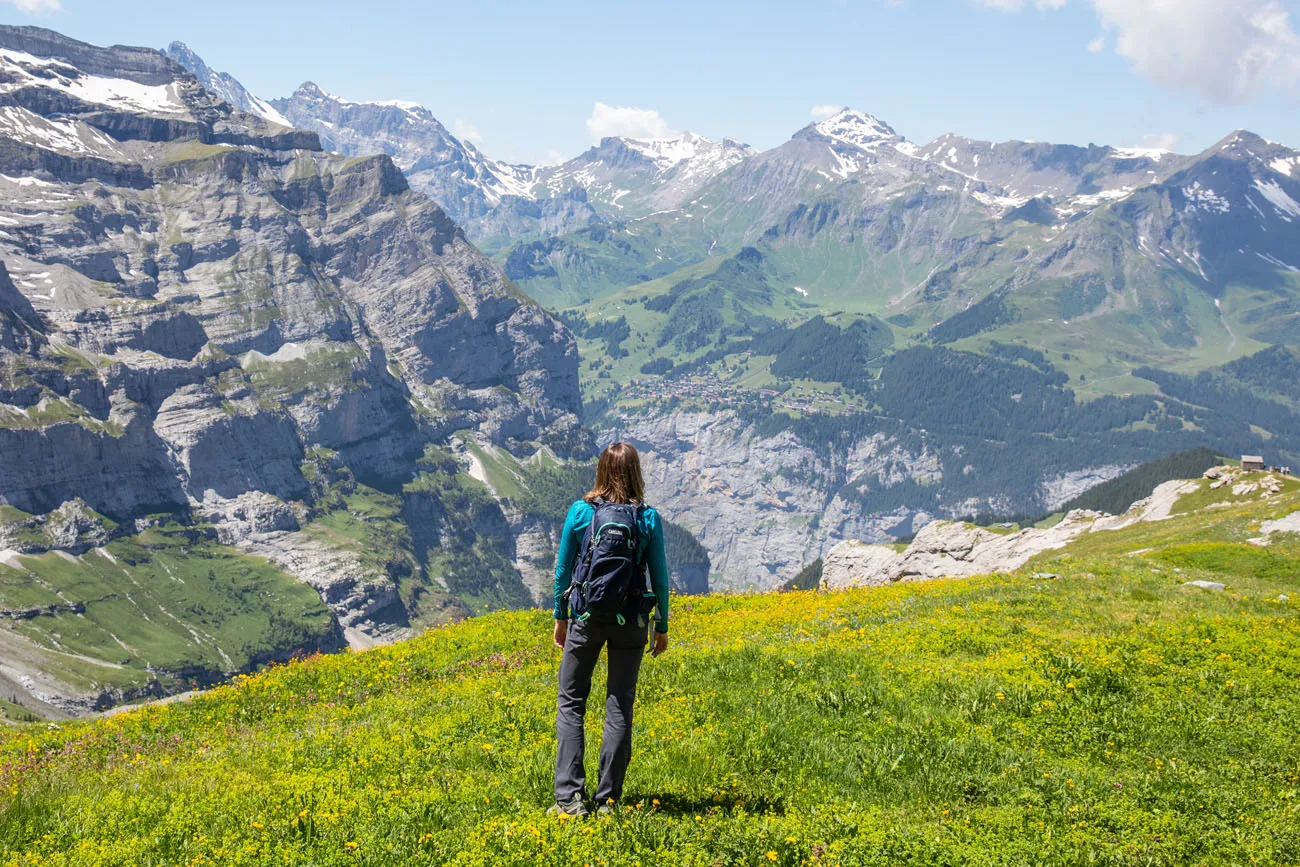
Best Things to Do in the Jungfrau Region of the Bernese Oberland
Jungfraujoch. A visit to Jungfraujoch is one of the best things to do in the Jungfrau region. Stand on one of the highest points in the Swiss Alps, walk through an ice cave, play in the snow, get panoramic views over the Alps, and hike out to Mönchsjochhütte.
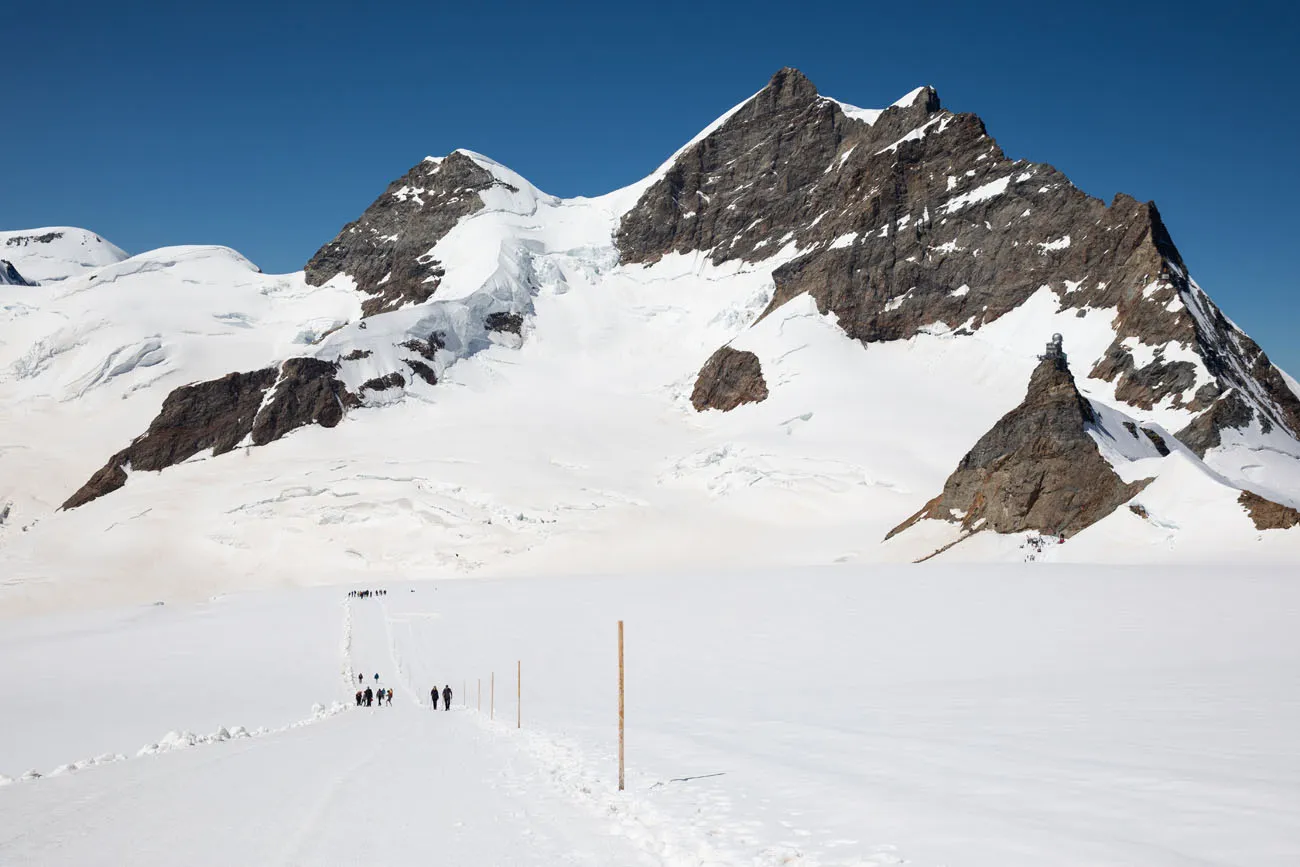
Jungfraujoch
Schilthorn and Piz Gloria. Schilthorn is one of the highest peaks in the Jungfrau region and it is one of the best places to go for panoramic views of the Swiss Alps. In 1969, Schilthorn was feature in the James Bond movie On Her Majesty’s Secret Service. While you are here, visit Bond World, tour the James Bond exhibits, and dine in the same restaurant featured in the movie (Piz Gloria).
IMPORTANT: A new cable car system is currently being constructed from Stechelberg to Mürren to Schilthorn. It will be replacing the original cable car route. The original cable cars are still in operation, so you can still visit Schilthorn, but readers are reporting that the Birg Thrill Walk is closed and that the construction materials are taking away from the view at Schilthorn. This construction project is planned through 2026. Learn more here.
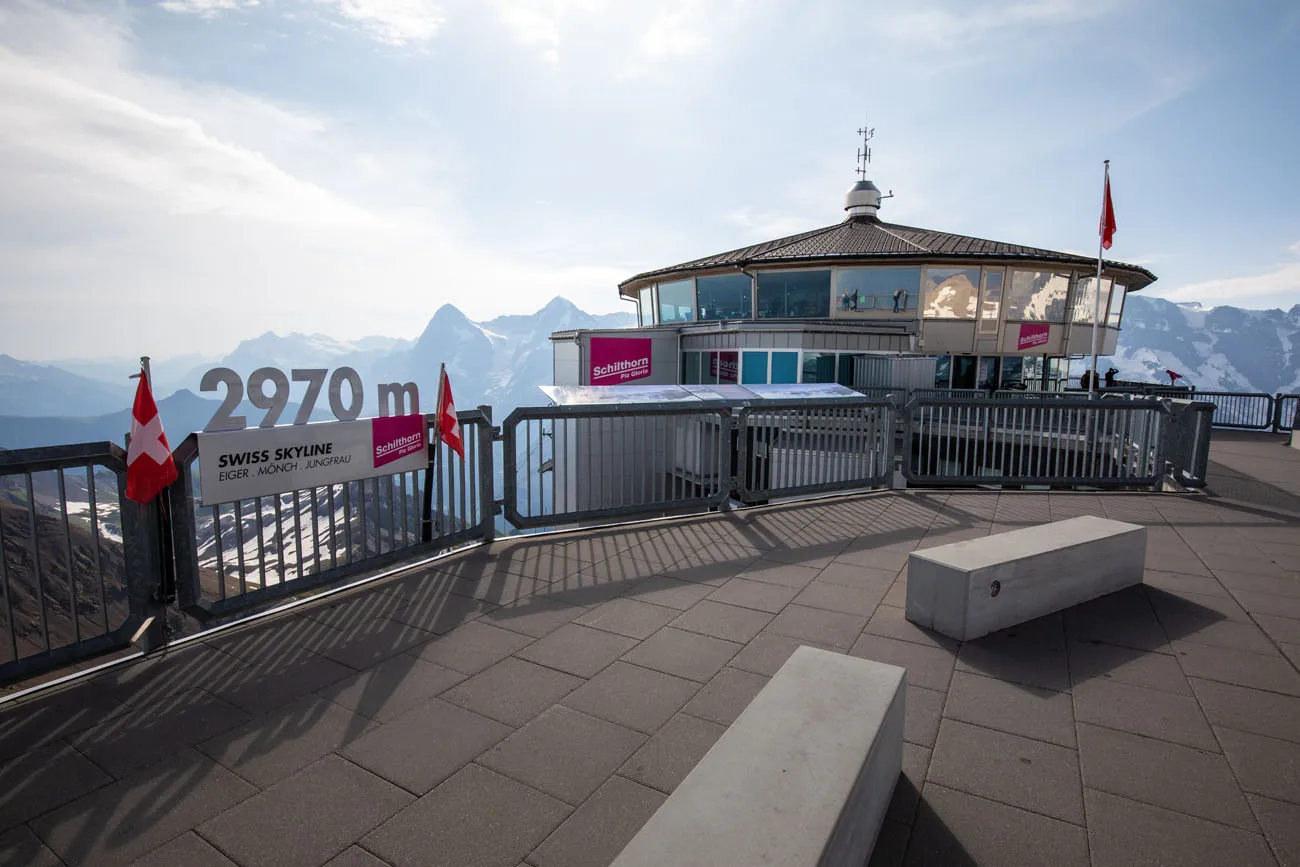
Go Hiking. One of the best ways to experience the Bernese Oberland is on a hiking trail. Take your pick from short, easy strolls to full day hikes. Our top recommendations are the Eiger Trail, the walk from Männlichen to Kleine Scheidegg, the Northface Trail, and if you want a spectacular full day hike, tackle the hike from Schynige Platte to Faulhorn to First. See the full list in our Bernese Oberland Hiking Guide.
Cliff Walks. There are two cliff walks in the Jungfrau region. The Birg Thrill Walk is located near Schilthorn. From here, you get a spectacular view of the Jungfrau massif. The First Cliff Walk is a similar experience, with views over Grindelwald. If you only have time for one, the Birg Thrill Walk is the winner (but be aware of the construction of the new cable car route, so the Birg Thrill Walk could periodically be closed).
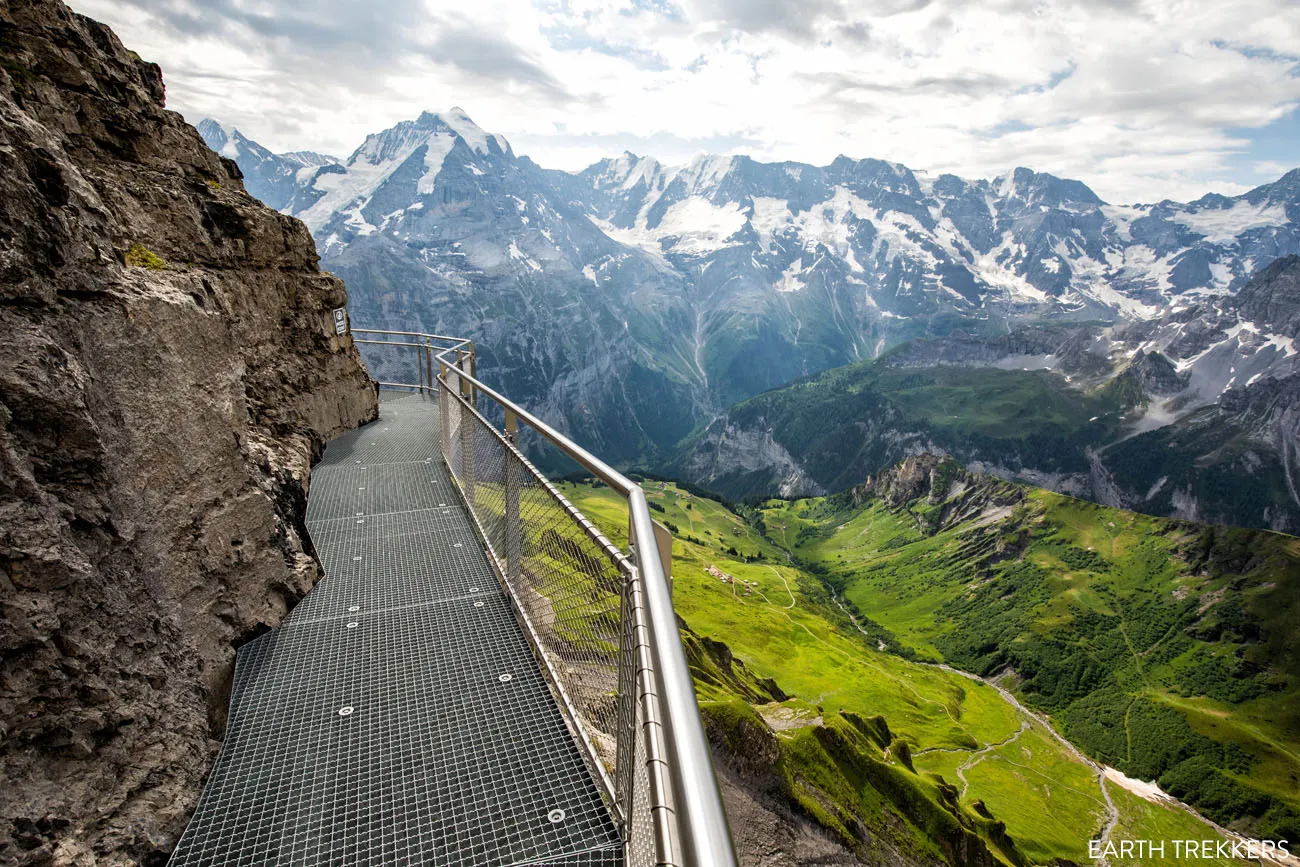
Birg Thrill Walk
Mürren Via Ferrata. For a big thrill, dangle over the Lauterbrunnen Valley on the Mürren via ferrata. On this 2.2 km journey, you will climb down steep ladders, walk on tightropes, cling to the cliffs holding onto iron bars, walk across a swaying suspension bridge, and (with a guide) zip line across a ravine.
Go Paragliding. Paragliding is one of the most thrilling things you can do in the Bernese Oberland. There are numerous companies that offer tandem paragliding, leaving from Interlaken or Mürren. It’s a bit pricey, coming in at around CHF 250, but what a view you will have!
Trummelbach Falls. Glacier melt from Mönch, Eiger, and Jungfrau drains down into this cavern, forming a series of waterfalls located entirely within a mountain. If it is a rainy day, this is one of the best things to do in the Jungfrau region.
Harder Kulm. Harder Kulm is a mountain that looms over Interlaken. From the top of Harder Kulm, you get an amazing view of the Bernese Alps, so this is a great way to start your tour of the Bernese Oberland. A 10-minute ride on a funicular zips you up to the top of Harder Kulm for a stunning view of the Swiss Alps. Stretched out in front of you are the mountains Mönch, Eiger and Jungfrau as well as views over Lake Brienz and Lake Thun.
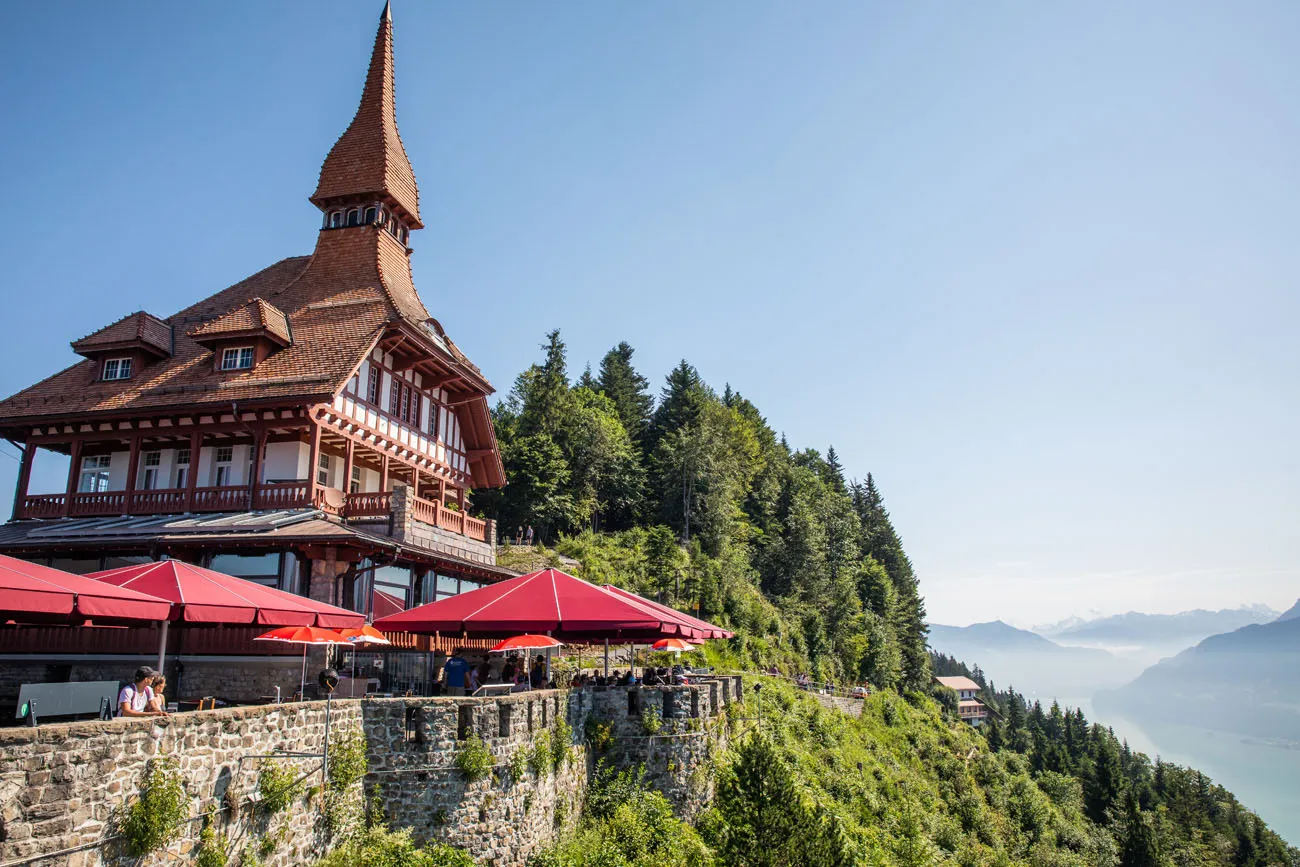
Harder Kulm
For the full list of things to do in the Bernese Oberland, read our article 20 Amazing Things to do in the Jungfrau Region of Switzerland.
How Many Days Should You Spend in the Bernese Oberland?
As many as possible. 😉
The Bernese Oberland is an extraordinary place. The alpine views, the thrilling rides on the cable cars, the scenic strolls through the small towns, the hiking trails…it would be very easy to spend a full week here and never run out of things to do.
We spent six days here and wished we had more time.
One or two days gives you just a taste of this region. Take the expensive but bucket list worthy trip up Jungfraujoch or Schilthorn, go hiking, and explore one or two of the charming towns. If you only have one day in the Jungfrau region, you could visit Jungfraujoch in the morning and hike the Eiger Trail and visit Kleine Scheidegg in the afternoon.
Three to five days gives you more time for hiking and to visit both the east and west sides of the valleys. It also gives you a little bit of contingency time if there is bad weather. When it gets cloudy and rainy, those spectacular mountain views disappear behind a blanket of clouds. Having an extra day or two ensures that you will get to see those views that you dream of.
With a full week, you can explore the nooks and crannies of the Jungfrau region, hike the longer trails, and have lots of leisurely time to sit back and enjoy the view.
To help you plan your visit, take a look at our Jungfrau Itinerary, which has suggestions on how to plan your time, from one day to one week.
Best Time to Visit the Bernese Oberland
You can visit the Bernese Oberland all year.
The best time to visit, in my opinion, is during the summer months, especially if you want to go hiking. Many of the hiking trails do not open until the end of May or early June, and then close in October, when the snow begins to fall. So, if you are a hiker, the best time to visit the Bernese Oberland is during the summer months.
Summer is peak season in the Bernese Oberland. It will be more crowded and expensive to visit at this time, so you will need to make your hotel reservations far in advance (ideally 4 to 6 months before your visit). But the weather is warm, the flowers are blooming, and the days are long.
If you want to hike the trails and have lower crowds, plan your visit for the end of September to early October.
We visited Switzerland in July. We saw the biggest crowds on Jungfraujoch, at First, and in Lauterbrunnen. Cable cars and trains are very crowded from 10 am through mid-afternoon, so it is best to plan your visits to Schilthorn, Jungfraujoch, and Schynige Platte first thing in the morning.
Spring and autumn can be a nice time to visit, with lower crowds and the chance to see area covered in snow. Many hiking trails will be closed but the ski slopes will be open, depending on your timing.
During winter months, the Bernese Oberland is a snow-covered wonderland. Ride the cable cars to Schilthorn and Jungfraujoch for spectacular views, go skiing, and spend the evenings in a cozy hotel with views of the snow-capped mountains.
Many of the trains and cable cars operate year round, although some will close for a short period of time for maintenance, either during the winter, spring, or fall months.
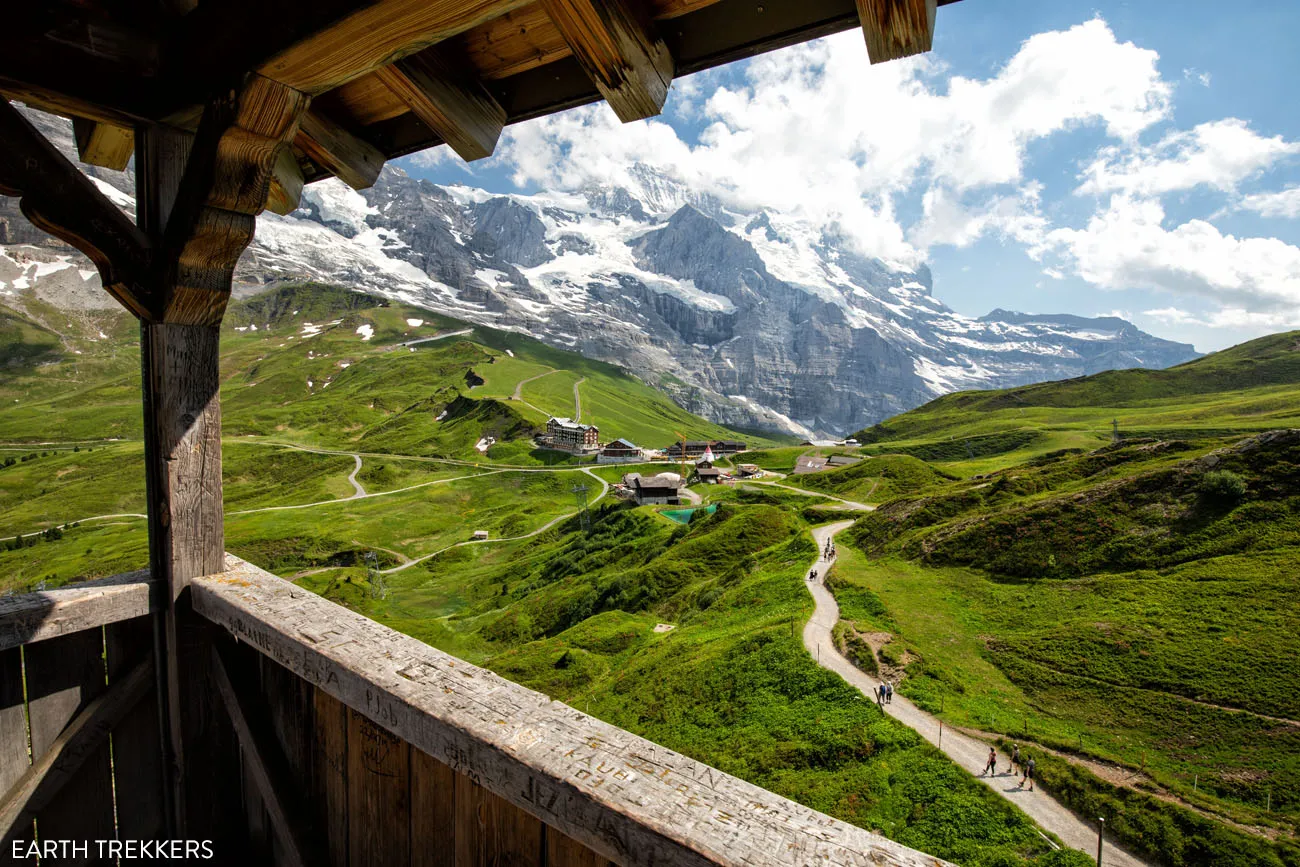
Where to Stay in the Jungfrau Region
Interlaken. Interlaken is the gateway into the Jungfrau region. This is a good place to stay if you only have one or two days to spend in the Jungfrau region and you are traveling through Switzerland.
Lauterbrunnen. Tucked away in the Lauterbrunnen Valley is the picturesque town of Lauterbrunnen. This is a handy home base, since you have easy access to the main trains and cable cars in the Jungfrau region. However, since it is located in the valley, this town lacks the high alpine views that you get in several other villages.
Grindelwald. Like Lauterbrunnen, Grindelwald is tucked away in a valley. It is a handy hub for getting around the region. Grindelwald lacks a lot of the charm that places like Mürren, Wengen, and Lauterbrunnen have, so it’s not our top pick as a place to stay.
Wengen. Wengen is located on the east side of the Lauterbrunnen Valley, just beneath Männlichen and Jungfraujoch. It is filled with lots of hotels and restaurants so it is one of the best places to stay in the Jungfrau region.
Mürren. Mürren clings to the cliffs on the west side of Lauterbrunnen Valley. This is a small town with lots of charm. If that’s not enough, throw in the spectacular view you have of Mönch, Eiger, and Jungfraujoch, making this an amazing place to stay in the Jungfrau region, especially if you want a hotel with view. We stayed in Mürren at the Alpenblick Hotel and loved it here. Without a doubt, we will stay in Mürren on our next visit to Switzerland.
Gimmelwald. Gimmelwald sits right next to Mürren so the views are very similar. This is a smaller town and a bit harder to get to, so it is also less touristy. Gimmelwald is a nice option for those with a long stay in the Jungfrau region who want to escape the crowds.
For more recommendations on where to stay, read our guide to Where to Stay in the Jungfrau Region. Learn where to stay for great views of the Swiss Alps and get recommendations whether you are looking for a budget hotel, luxury hotel, or if you are traveling as a family.
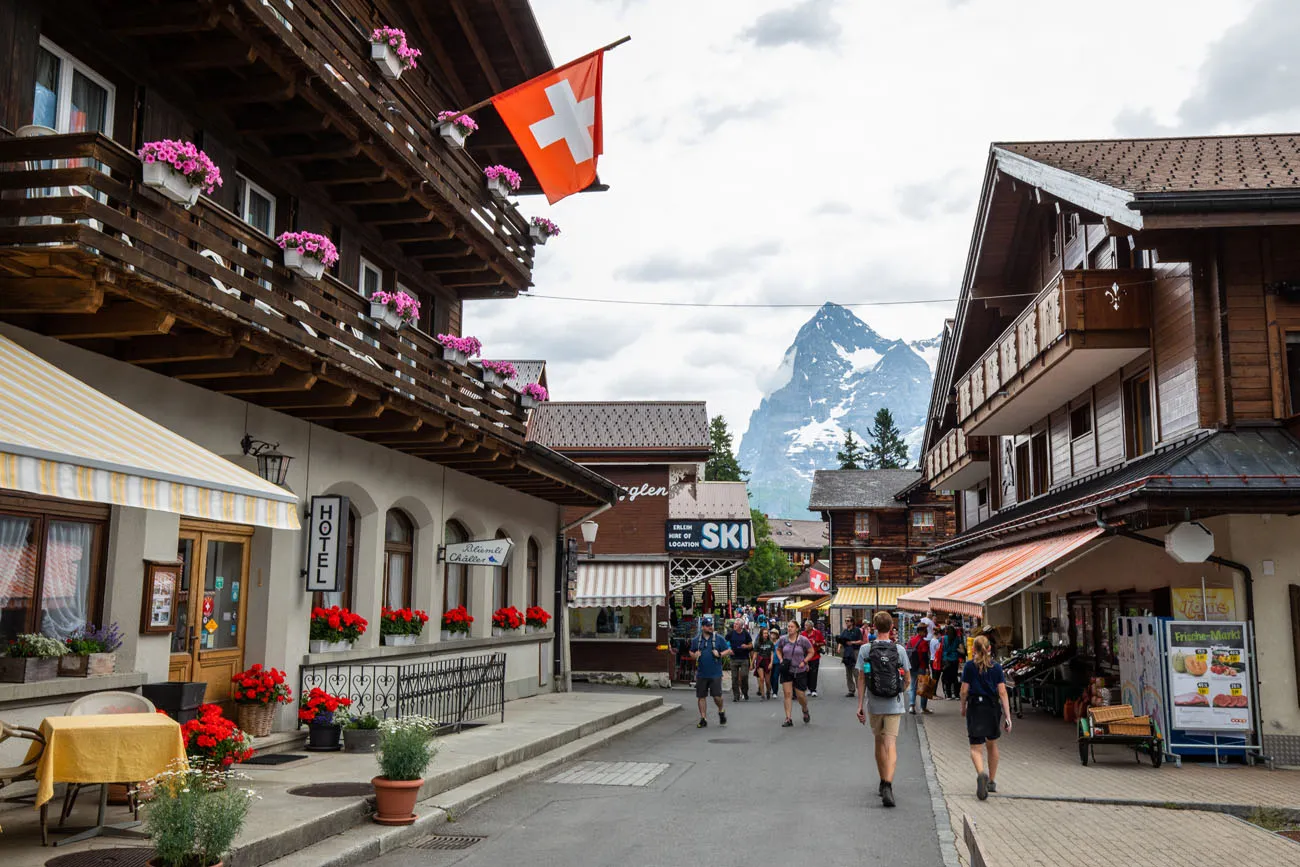
Mürren
If you have any questions about what to do in the Bernese Oberland and how to plan your visit, let us know in the comment section below.
More Places to Go in Switzerland
SWITZERLAND ITINERARY: If your visit to the Bernese Oberland is part of a bigger trip to Switzerland, check out our Switzerland Itinerary, which has suggestions on what to do if you have 7 days, 14 days, or even longer.
LUCERNE: Learn how to spend one perfect day in Lucerne with a trip to Mt. Pilatus.
ZÜRICH: For things to do on a quick visit, check out our article One Day in Zürich.
ZERMATT: In Zermatt, don’t miss the hike from Gornergrat to Riffelberg. For more ideas on what to do, read our article Best Things to Do in Zermatt. For more alpine views, learn how to visit Matterhorn Glacier Paradise (and find out if it is worth it) and how to climb to the summit of Breithorn.
LAUSANNE: Lausanne is another beautiful Swiss city with lots of great things to do and it also is a great home base for day trips in the area, such as Gruyères and Chateau de Chillon.
LUGANO: Lugano is located in southern Switzerland. From here, you can visit the fairytale bridge Ponte dei Salti and you can easily day trip to Lake Como and Bellagio.
We have TONS more information about Switzerland in our Switzerland Travel Guide, including Zürich, Lucerne, the Bernese Oberland, Zermatt, Lugano, and Lausanne.
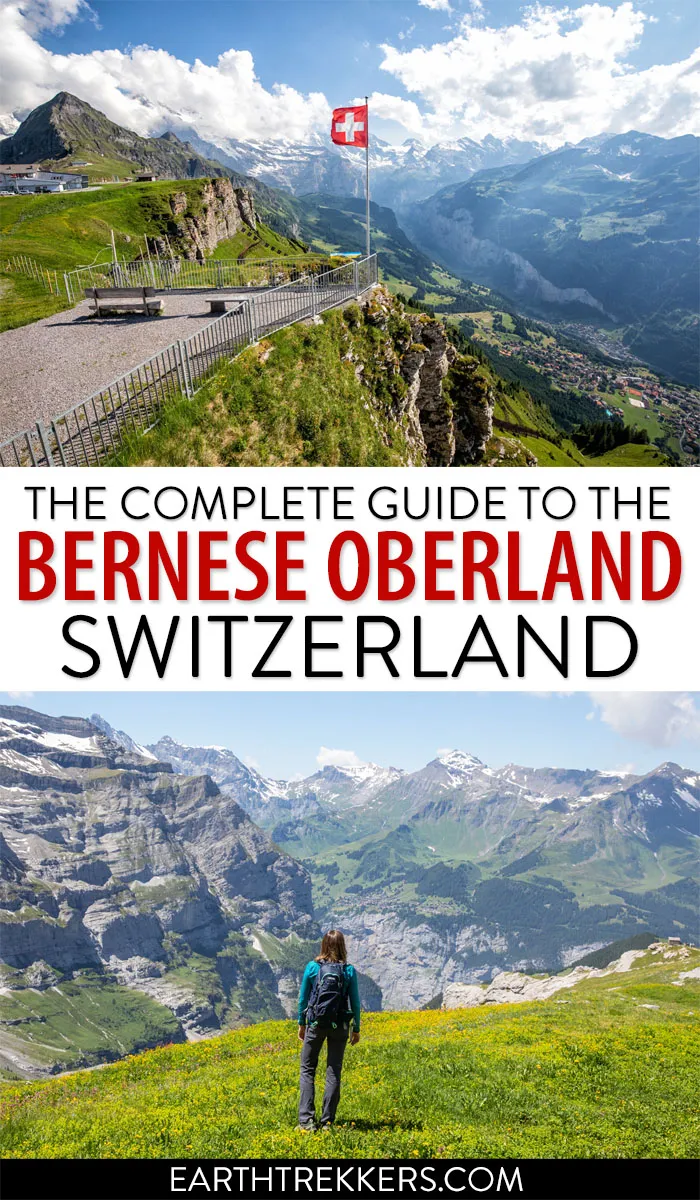
Note: This post contains affiliate links. When you make a purchase using one of these affiliate links, we get paid a small commission at no extra cost to you.
All rights reserved © Earth Trekkers. Republishing this article and/or any of its contents (text, photography, etc.), in whole or in part, is strictly prohibited.
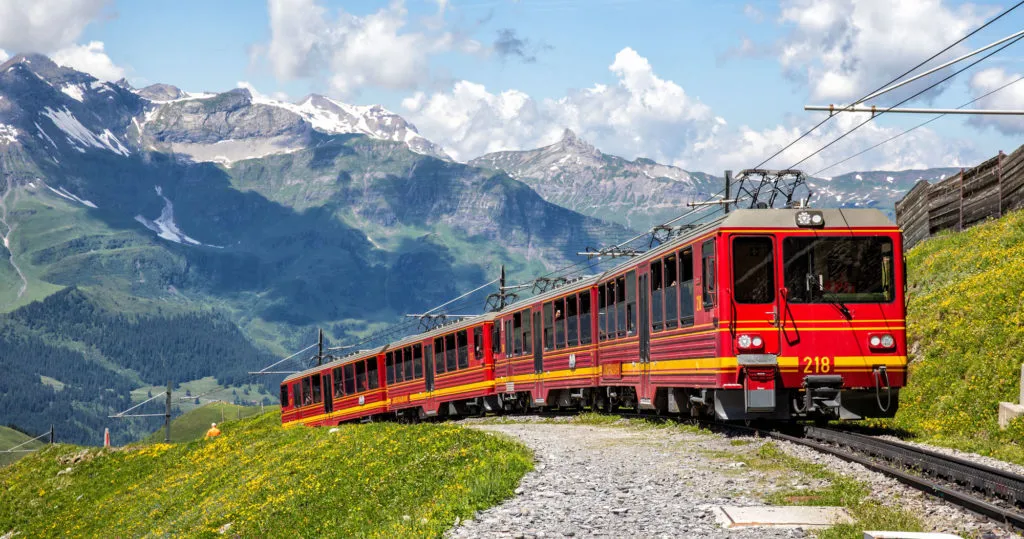
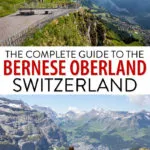

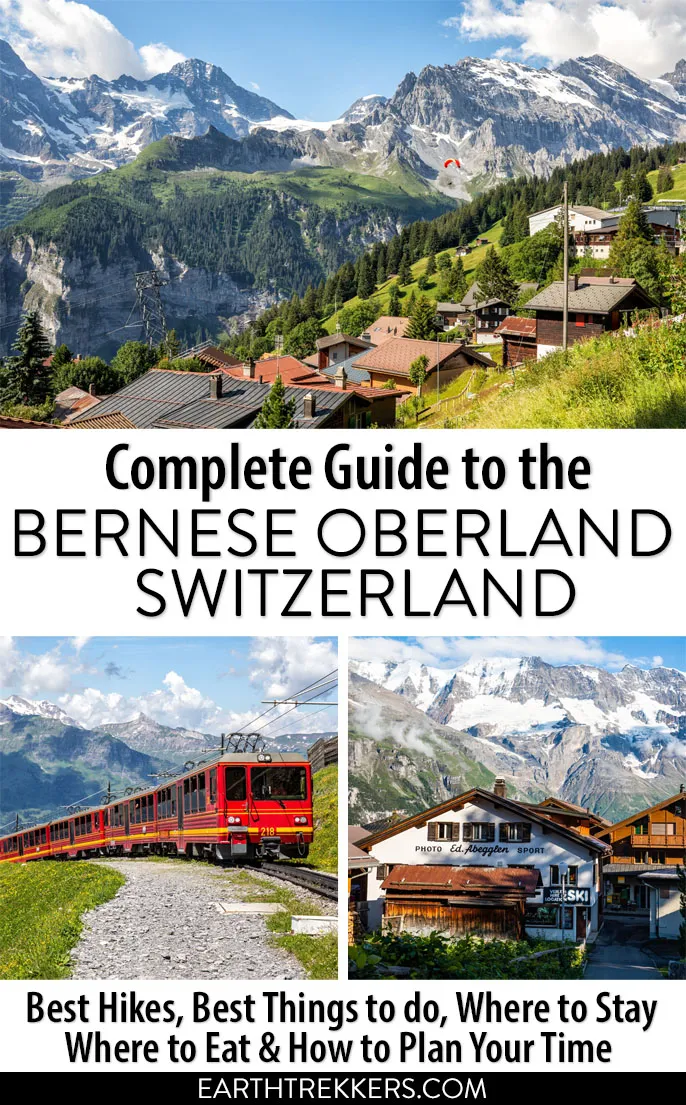
Comments 77